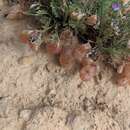Comprehensive Description
provided by North American Flora
Phaca jejuna (S. Wats.) Rydb. Bull. Torrey Club 40: 48. 1913
Astragalus jejunus S. Wats. Bot. King's Expl. 73. 1871. Tragacantha jejuna Kuntze, Rev. Gen. 945. 1891.
Perennial, with a thick root and cespitose caudex; stems numerous, 3-5 cm. high, below covered with imbricate, membranous, connate, ciliate stipules; leaves about 2 cm. long; leaflets 7-15, linear, 2-5 mm. long; peduncles shorter than the leaves; racemes 1-3-flowered; calyx strigose, the tube nearly 2 mm. long, the lobes subulate, 1 mm. long; corolla ochroleucous, tinged with violet, 4 mm. long; banner obovate, retuse; wings slightly shorter, the blade obovate, with an acute basal auricle; keel-petals much shorter and broader, obtuse; pod sessile, slightly puberulent or glabrate, about 1 cm. long, sub-globose, usually somewhat mottled.
Type locality: Bear River Valley, near Evanston. Utah [now Wyoming|.
Distribution: Western Wyoming and northern Utah.
- bibliographic citation
- Per Axel Rydberg. 1919. (ROSALES); FABACEAE; PSORALEAE. North American flora. vol 24(1). New York Botanical Garden, New York, NY
Physical Description
provided by USDA PLANTS text
Perennial, Herbs, Stems woody below, or from woody crown or caudex, Taproot present, Nodules present, Stems very short, acaulescent or subacaulescent, Stems less than 1 m tall, Stems solid, Stems or young twigs sparsely to densely hairy, Leaves alternate, Leaves petiolate, Stipules conspicuous, Stipules membranous or chartaceous, Stipules persistent, Stipules connate to each other, forming a tuber or sheath, Leaves compound, Leaves odd pinnate, Leaf or leaflet margins entire, Leaflets opposite, Leaflets 5-9, Leaflets 10-m any, Leaves hairy on one or both surfaces, Inflorescences racemes, Inflorescence axillary, Bracts very small, absent or caducous, Flowers zygomorphic, Calyx 5-lobed, Calyx glabrous, Petals separate, Corolla papilionaceous, Petals clawed, Petals pinkish to rose, Petals blue, lavander to purple, or violet, Petals bicolored or with red, purple or yellow streaks or spots, Banner petal narrow or oblanceolate, Wing petals narrow, oblanceolate to oblong, Wing tips obtuse or rounded, Keel petals auriculate, spurred, or gibbous, Keel tips obtuse or rounded, not beaked, Stamens 9-10, Stamens diadelphous, 9 united, 1 free, Filaments glabrous, Style terete, Style persistent in fruit, Fruit a legume, Fruit unilocular, Fruit freely dehiscent, Fruit orbicular to subglobose, Fruit exserted from calyx, Fruit inflated or turgid, Fruit beaked, Fruit glabrous or glabrate, Fruit hairy, Fruit 11-many seeded, Seeds cordiform, mit-shaped, notched at one end, Seed surface smooth, Seeds olive, brown, or black.

